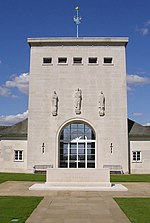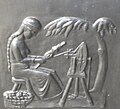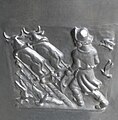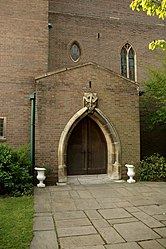Vernon Hill (sculptor)
Vernon Hill | |
|---|---|
 "Shepherding", Guildford Cathedral | |
| Born | 1887 Halifax, Yorkshire |
| Died | 1972 England |
| Nationality | English |
| Known for | Sculpture, illustration, lithography |
Vernon Hill (1887–1972), born in Halifax, Yorkshire, England, was a sculptor, lithographer, illustrator and draughtsman.[1][dead link]
He began his work in print-making and lithography, and branched out into other artistic forms, such as sculpture. He illustrated several works and created etchings. His more notable works were commissions from Sir Edward Maufe for interior and exterior architectural sculptures on Maufe's buildings, including Guildford Cathedral, the Runnymede Memorial and several churches.
Early life
[edit]Vernon Hill was born in 1887 in Halifax, Yorkshire. He began formal training in print-making at an early age; at the age 13 he was apprenticed to a lithographer. In about 1908, at the age of 21, Hill moved to London and took up poster illustration, working under John Hassall, a poster designer and illustrator.[1][4]
From 1909 to 1914 Hill received commissions for work as an illustrator on various projects. He created Art Nouveau illustrations for an Arcadian Calendar for 1910 in 1909, Stephen Phillips' The New Inferno in 1911 and for Richard Pearse Chope's Ballads Weird and Wonderful the following year. In 1912 one of his works was exhibited at the Royal Academy.[1][dead link][4] His etchings were described by Campbell Fine Art as follows:
The distinctive allegorical etchings of Vernon Hill are all now scarce. His highly evocative work appears to have evolved entirely independently from the trends of his time, although overtones of the mysticism which so influenced Frederick Carter and Austin Osman Spare can be traced in some of his works.[4]
Richard Pearse Chope commissioned Hill to create a series of designs for Roof Bosses at St. Nectan church, Stoke, Hartland c.1912. The bosses are in three sets; two sets are of plants and trees of which the first letter of each spell out the names of Chope's brothers (Dennis & Abbot Chope). The third set are of biblical associations. Hill is thought to have sculpted these bosses although some indicate they were done by Messers Reads of Exeter.[5]
Notable commissions
[edit]His most notable work as a sculptor is to be seen on various buildings by Sir Edward Maufe, who regularly commissioned Hill.
Guildford Cathedral
[edit]Some of Hill's finest work can be seen at Guildford Cathedral in Guildford, Surrey. Apart from the reliefs on the south door entrance he carved the angels on the sedilia inside the cathedral, as well as the tongues of flame on the pulpit and lectern. He also carved the arms of Bishop Greig over the inside of the sacristy door and the figure of Saint Ursula over the inside of St Ursula's Porch.[6][7]
At the east door of the south porch (on either side of the central buttress pier in the south transept) are two magnificent bronze doors set under two arches which feature Vernon Hill's reliefs.[8][9] These are depictions of various occupations, of both men and women. The men's occupations are on the right-hand door and include sowing, woodcutting, fishing, hunting, shepherding and ploughing; on the left-hand door are depicted women's traditional occupations including milking, spinning, and teaching.[6][7]
-
Teaching
-
Milking
-
Spinning
-
Sowing
-
Shepherding
-
Ploughing
Runnymede Memorial
[edit]
Hill sculpted the Air Forces Memorial at Runnymede, designed by Maufe.[10] Overlooking the Thames Valley, the memorial commemorates the more than 20,000 Royal Air Force servicemen and -women who died during World War II and have no known graves. The panels of inscriptions bear their names.[11]
Among Hill's works are the architectural sculptures of Courage, Victory and Justice, which adorn the entry to the shrine on the north side of the triple arched portico by the cloisters.[12]
St Columba's Church, London
[edit]
Maufe was the architect for the re-building of St Columba's Church, Pont Street, London, which had been destroyed in 1941 during World War II. Hill provided interior and exterior stone sculptures for the construction between 1950 and 1955. Maufe described the finished work as "of an especial beauty."[13]
St John's College, Cambridge
[edit]Also commissioned by Maufe, Hill completed an architectural sculpture of the arms of St John's College, Cambridge, for the north side of North Court.[14]
Church of St Thomas the Apostle, Hanwell
[edit]Hill sculpted several works out of Weldon stone for Maufe's church of St Thomas the Apostle, Hanwell. These included a sculpture of doves over the north door and one of two birds eating a bunch of grapes, depicting the Communion, over the west door. He also carved a Virgin and Child and a font. The font includes symbols for Christ, such as the ΙΧΘΥΣ cypher and an image of a fish. He also made a sculpture of Saint Christopher.[15][16][17][18]
-
Hill's keystone carving of a dove over the north door
-
Virgin and Child, carved in Caen stone, in the Morning Chapel (Lady Chapel)
Works
[edit]| Work | Year | Type of work | Notes and References |
|---|---|---|---|
| A girl decked with leaves | 1905–1930 | Etching | The etching shows the head of a woman with leaves in her hair. It is printed with plate-tone in brown ink on speckled buff paper.[19] |
| Air Maidens | 1927 (exhibited) | Sculpture | The wooden figure group was exhibited at Sculpture, Drawings and Etchings by Vernon Hill (Leicester Galleries) in 1927.[20] |
| Back of Hand-mirror | 1927 (exhibited) | Sculpture | The bronze cast sculpture was exhibited at Leicester Galleries for the "Sculpture, Drawings and Etchings by Vernon Hill" exhibit.[21] |
| Ballads Weird and Wonderful | 1912 | Illustrations | Hill illustrated a book of ancient legendary ballads.[22][nb 2] For example, see Young Benjie. |
| Blind | 1902–1915 | Walking in the dark is a ragged old man (etching and aquatint).[23] | |
| Crescent Moon | 1927 (exhibited) | Sculpture | The lead sculpture was exhibited at Leicester Galleries for the "Sculpture, Drawings and Etchings by Vernon Hill" exhibit.[24] |
| Dawn with Trumpet | 1905–1924 | The etching, of an "allegorical figure in flowing rows blowing trumpet in doorway", is printed with plate-tone in brown ink.[25] | |
| Day joy | 1927 (exhibited) | Sculpture | The bronze cast sculpture was exhibited at Leicester Galleries for the "Sculpture, Drawings and Etchings by Vernon Hill" exhibit.[26] |
| Door Knocker | 1927 (exhibited) | Architectural sculpture | The bronze cast door knocker was exhibited at Leicester Galleries for the "Sculpture, Drawings and Etchings by Vernon Hill" exhibit.[27] |
| Elfin Crown | 1927 (exhibited) | Sculpture | The bronze cast sculpture was exhibited at Leicester Galleries for the "Sculpture, Drawings and Etchings by Vernon Hill" exhibit.[28] |
| Evening | 1905–1915 | The work depicts two sitting figures: a woman sitting near a fire and a satyr holding a crook.[29] | |
| Fire | 1905–1915 | The work, an etching, depicts a naked man walking in flames while shielding his face.[30] | |
| The Guardian | 1905–1915 | A seated semi-nude angel is holding a branch of leaves and a trumpet. The work is an etching.[31] | |
| Mermaid | 1927 (exhibited) | Sculpture | The carved animal bone sculpture was exhibited at Leicester Galleries for the "Sculpture, Drawings and Etchings by Vernon Hill" exhibit.[32] |
| Moon Maidens | 1927 (exhibited) | Sculpture | The wood carved sculpture was exhibited at Leicester Galleries for the "Sculpture, Drawings and Etchings by Vernon Hill" exhibit.[33] |
| Moon Maidens | 1930 (exhibited) | Sculpture | The bronze sculpture was exhibited at Leeds City Art Gallery, Yorkshire Artists' Exhibition in 1928.[34] |
| Morning Gladness | 1927 (exhibited) | Sculpture | The bronze cast sculpture was exhibited at Leicester Galleries for the "Sculpture, Drawings and Etchings by Vernon Hill" exhibit.[35] |
| Night | 1927 (exhibited) | Sculpture | The carved stone sculpture was exhibited at Leicester Galleries for the "Sculpture, Drawings and Etchings by Vernon Hill" exhibit.[36] |
| Nymph | 1927 (exhibited) | Sculpture | The bronze cast sculpture was exhibited at Leicester Galleries for the "Sculpture, Drawings and Etchings by Vernon Hill" exhibit.[37] |
| Rapture | 1927 (exhibited) | Sculpture | The bronze cast sculpture was exhibited at Leicester Galleries for the "Sculpture, Drawings and Etchings by Vernon Hill" exhibit.[38] |
| Roaring flame | 1927 (exhibited) | Sculpture | The bronze cast sculpture was exhibited at Leicester Galleries for the "Sculpture, Drawings and Etchings by Vernon Hill" exhibit.[39] |
| Sea Frolic | 1927 (exhibited) | The work is a photomechanical print invitation of three entwined mermaids for the Leicester Galleries Exhibition of Sculpture, Drawings and Etchings by Vernon Hill in 1927.[40] | |
| Sorrow | 1927 (exhibited) | Sculpture | The carved marble sculpture was exhibited at Leicester Galleries for the "Sculpture, Drawings and Etchings by Vernon Hill" exhibit.[41] |
| St Joan of Arc's Church sculpture | Unknown | Sculpture | Hill made a sculpture for the church; further details are unknown.[42] |
| The Arcadian Calendar | 1909 | Illustration | The calendar is believed to contain Hill's first commissioned illustrations. The work was published by John Lane The Bodley Head. |
| The Awakening | 1930 (exhibited) | Sculpture | The bronze sculpture was exhibited at Leeds City Art Gallery, Yorkshire Artists' Exhibition in 1930.[43] |
| The Chase | 1928 (exhibited) | Sculpture | The bronze sculpture was exhibited at Leeds City Art Gallery, Yorkshire Artists' Exhibition in 1928.[44] |
| The Flower of Silence | 1927 (exhibited) | Sculpture | The carved wood sculpture was exhibited at Leicester Galleries for the "Sculpture, Drawings and Etchings by Vernon Hill" exhibit.[45] |
| The Mask | 1927 (exhibited) | Sculpture | The bronze cast sculpture was exhibited at Leicester Galleries for the "Sculpture, Drawings and Etchings by Vernon Hill" exhibit.[46] |
| The Messenger | 1905–1915 | The work depicts a man naked except for winged sandals flying above the mountains while carrying a banner.[47] | |
| The Moon Chariot | 1927 (exhibited) | Sculpture | The lead sculpture was exhibited at Leicester Galleries for the "Sculpture, Drawings and Etchings by Vernon Hill" exhibit.[48] |
| The New Inferno | 1910 | Illustration | Hill created Art Nouveau illustrations for S. Phillips' The New Inferno in 1911.[1][4] |
| The Spirit that destroyed Rheims | 1905–1915 | An etching, made on cream paper, depicting a figure brandishing a sword while bursting through flames.[49] | |
| The Sun God | 1927 (exhibited) | Sculpture | The carved stone sculpture was exhibited at Leicester Galleries for the "Sculpture, Drawings and Etchings by Vernon Hill" exhibit.[50] |
| The Wave | 1927 (exhibited) | Sculpture | The carved marble sculpture was exhibited at Leicester Galleries for the "Sculpture, Drawings and Etchings by Vernon Hill" exhibit.[51] |
| The Wheel | 1927 (exhibited) | Sculpture | The bronze cast sculpture was exhibited at Leicester Galleries for the "Sculpture, Drawings and Etchings by Vernon Hill" exhibit.[52] |
| The woman-wind asleep | 1927 (exhibited) | Sculpture | The lead sculpture was exhibited at Leicester Galleries for the "Sculpture, Drawings and Etchings by Vernon Hill" exhibit.[53] |
| Tramping with a Poet through the Rockies | Before 1922 | Illustrations | Hill illustrated the travel journal of authors Vachel Lindsay and Stephen Graham through the United States and Canadian Rockies, with stops at an Indian reservation and a Mormon temple.[54] |
| Wind Helmet | 1927 (exhibited) | Sculpture | The bronze cast sculpture was exhibited at Leicester Galleries for the "Sculpture, Drawings and Etchings by Vernon Hill" exhibit.[55] |
Exhibitions
[edit]Hill exhibited:[1]
- 1927 - Multiple works at Leicester Galleries: Sculpture, Drawings and Etchings by Vernon Hill
- 1928 - Multiple works at Leeds City Art Gallery, Yorkshire Artists' Exhibition
- 1930 - The Awakening at Leeds City Art Gallery, Yorkshire Artists' Exhibition
Notes
[edit]- ^ Wolseley Fine Arts exhibition catalogue also gives 1972 as his date of death.[2][dead link] According to Christie's, however, he died in 1953.[3]
- ^ Hill's artistic talents were described by Chope in the Foreword to Ballads Weird and Wonderful as follows: "[he] is an artist who is not limited to the actual things of life, whose fancy is not confined within the limits of a green field or a marble column - who, indeed, can see visions - whose inner life is not of our life but of a strange occult devising, is impelled irresistibly towards the supernatural."
References
[edit]- ^ a b c d e f [dead link]Vernon Hill. Mapping the Practice and Profession of Sculpture in Britain and Ireland 1851-1951, University of Glasgow History of Art and HATII, online database 2011. Retrieved 23 August 2012.
- ^ The Etchings Revival in Britain 1850-1950. Wolseley Fine Arts. p. 25. Retrieved 23 August 2012.
- ^ Lot Finder - Vernon Hill. Christie's. Retrieved 23 August 2012.
- ^ a b c d Vernon Hill: Biography. Campbell Fine Art. Retrieved 23 August 2012.
- ^ Hobbs; Question of a Seat. Pub. 2005 on the seating and artefacts within St Nectans church
- ^ a b Exterior Guide Guildford Cathedral.. Retrieved 16 August 2012
- ^ a b Cathedral Church of the Holy Spirit, Guildford. British Listed Buildings. Retrieved 19 August 2012.
- ^ Guildford Cathedral, east door of south porch, Elemental Male Occupations Ploughman. Work of Vernon Hill. Exploring Surrey's Past. Archive record Reference Number: PC 00072 ALB00300149. Retrieved 24 August 2012.
- ^ Historic England. "Cathedral Church of the Holy Spirit (1377883)". National Heritage List for England. Retrieved 24 August 2012.
- ^ Runnymede Memorial. Commonwealth War Graves Commission. Retrieved 23 August 2012.
- ^ 207 Squadron Royal Air Force Association, The Air Forces Memorial, Coopers Hill, Runnymede. 207 Squadron (Royal Air Force) Association. Retrieved 24 August 2012.
- ^ The Air Forces Memorial, Runnymede. Commonwealth War Graves Commission. p. 4. Retrieved 24 August 2012.
- ^ 02 20-39 Chelsea Old Town Hall to Knightsbridge. Royal Borough of Kensington and Chelsea. p. 19. (item #39) Retrieved 24 August 2012.
- ^ Pevsner, Nikolaus. (1970). Cambridgeshire, Second edition. Pevsner Architectural Guides. Buildings of England. Yale University Press. ISBN 0-300-09586-4. pp. 154-155.
- ^ Cherry, Bridget and Nikolaus Pevsner. (1991). London 3: North West. Yale University Press. p. 184. Retrieved 23 August 2012.
- ^ Our Building St Thomas the Apostle, Hanwell. Retrieved 24 August 2012.
- ^ St Thomas the Apostle. London Open House. Open-City the architecture education organisation. Retrieved 24 August 2012.
- ^ Historic England. "Church of St Thomas the Apostle (1244068)". National Heritage List for England. Retrieved 24 August 2012.
- ^ A girl decked with leaves The British Museum. Retrieved 24 August 2012.
- ^ Air Maidens. Mapping the Practice and Profession of Sculpture in Britain and Ireland 1851-1951, University of Glasgow History of Art and HATII, online database 2011. Retrieved 23 August 2012.
- ^ Back of Hand-mirror. Mapping the Practice and Profession of Sculpture in Britain and Ireland 1851-1951, University of Glasgow History of Art and HATII, online database 2011. Retrieved 23 August 2012.
- ^ The International studio, Volume 48. John Lane Company, 1913. p. 346.
- ^ Blind. The British Museum. Retrieved 24 August 2012.
- ^ Crescent Moon. Mapping the Practice and Profession of Sculpture in Britain and Ireland 1851-1951, University of Glasgow History of Art and HATII, online database 2011. Retrieved 23 August 2012.
- ^ Dawn with Trumpet The British Museum. Retrieved 24 August 2012.
- ^ Day joy. Mapping the Practice and Profession of Sculpture in Britain and Ireland 1851-1951, University of Glasgow History of Art and HATII, online database 2011. Retrieved 23 August 2012.
- ^ Door Knocker. Mapping the Practice and Profession of Sculpture in Britain and Ireland 1851-1951, University of Glasgow History of Art and HATII, online database 2011. Retrieved 23 August 2012.
- ^ Elfin Crown. Mapping the Practice and Profession of Sculpture in Britain and Ireland 1851-1951, University of Glasgow History of Art and HATII, online database 2011. Retrieved 23 August 2012.
- ^ Evening The British Museum. Retrieved 24 August 2012.
- ^ Fire The British Museum. Retrieved 24 August 2012.
- ^ The Guardian The British Museum. Retrieved 24 August 2012.
- ^ Mermaid. Mapping the Practice and Profession of Sculpture in Britain and Ireland 1851-1951, University of Glasgow History of Art and HATII, online database 2011. Retrieved 23 August 2012.
- ^ Moon Maidens. Mapping the Practice and Profession of Sculpture in Britain and Ireland 1851-1951, University of Glasgow History of Art and HATII, online database 2011. Retrieved 23 August 2012.
- ^ Moon Maidens. Mapping the Practice and Profession of Sculpture in Britain and Ireland 1851-1951, University of Glasgow History of Art and HATII, online database 2011. Retrieved 23 August 2012.
- ^ Morning Gladness. Mapping the Practice and Profession of Sculpture in Britain and Ireland 1851-1951, University of Glasgow History of Art and HATII, online database 2011. Retrieved 23 August 2012.
- ^ Night. Mapping the Practice and Profession of Sculpture in Britain and Ireland 1851-1951, University of Glasgow History of Art and HATII, online database 2011. Retrieved 23 August 2012.
- ^ Nymph. Mapping the Practice and Profession of Sculpture in Britain and Ireland 1851-1951, University of Glasgow History of Art and HATII, online database 2011. Retrieved 23 August 2012.
- ^ Rapture. Mapping the Practice and Profession of Sculpture in Britain and Ireland 1851-1951, University of Glasgow History of Art and HATII, online database 2011. Retrieved 23 August 2012.
- ^ Roaring flame. Mapping the Practice and Profession of Sculpture in Britain and Ireland 1851-1951, University of Glasgow History of Art and HATII, online database 2011. Retrieved 23 August 2012.
- ^ Sea Frolic. The British Museum. Retrieved 24 August 2012.
- ^ Sorrow. Mapping the Practice and Profession of Sculpture in Britain and Ireland 1851-1951, University of Glasgow History of Art and HATII, online database 2011. Retrieved 23 August 2012.
- ^ Nairn, Ian and Nikolaus Pevsner. (1971). Surrey, Revised and Enlarged. Yale University Press. p. 232. 0-300-09675-5.
- ^ The Awakening. Mapping the Practice and Profession of Sculpture in Britain and Ireland 1851-1951, University of Glasgow History of Art and HATII, online database 2011. Retrieved 23 August 2012.
- ^ The Chase. Mapping the Practice and Profession of Sculpture in Britain and Ireland 1851-1951, University of Glasgow History of Art and HATII, online database 2011. Retrieved 23 August 2012.
- ^ The Flower of Silence. Mapping the Practice and Profession of Sculpture in Britain and Ireland 1851-1951, University of Glasgow History of Art and HATII, online database 2011. Retrieved 23 August 2012.
- ^ The Mask. Mapping the Practice and Profession of Sculpture in Britain and Ireland 1851-1951, University of Glasgow History of Art and HATII, online database 2011. Retrieved 23 August 2012.
- ^ The Messenger The British Museum. Retrieved 24 August 2012.
- ^ The Moon Chariot. Mapping the Practice and Profession of Sculpture in Britain and Ireland 1851-1951, University of Glasgow History of Art and HATII, online database 2011. Retrieved 23 August 2012.
- ^ The Spirit that destroyed Rheims The British Museum. Retrieved 24 August 2012.
- ^ The Sun God. Mapping the Practice and Profession of Sculpture in Britain and Ireland 1851-1951, University of Glasgow History of Art and HATII, online database 2011. Retrieved 23 August 2012.
- ^ The Wave. Mapping the Practice and Profession of Sculpture in Britain and Ireland 1851-1951, University of Glasgow History of Art and HATII, online database 2011. Retrieved 23 August 2012.
- ^ The Wheel. Mapping the Practice and Profession of Sculpture in Britain and Ireland 1851-1951, University of Glasgow History of Art and HATII, online database 2011. Retrieved 23 August 2012.
- ^ The woman-wind asleep. Mapping the Practice and Profession of Sculpture in Britain and Ireland 1851-1951, University of Glasgow History of Art and HATII, online database 2011. Retrieved 23 August 2012.
- ^ Bookseller and stationer, Volume 57. Princeton University, 1922. p. 30.
- ^ Wind Helmet. Mapping the Practice and Profession of Sculpture in Britain and Ireland 1851-1951, University of Glasgow History of Art and HATII, online database 2011. Retrieved 23 August 2012.
External links
[edit]- Vernon Hill works, images and files at The National Archives.
- The Art of Vernon Hill, Spirit of the Ages site
- The Arcadian Calendar images
- The Arcadian Calendar (The Art of Vernon Hill) video on YouTube
- Justice, Victory and Courage sculptures, Runnymede
- St Columba's Church of Scotland: St Columba with crane
- St John's College: coat of arms with yales
- St Thomas the Apostle, Hanwell - images
- Stephen Graham, World Traveler. Painting by Hill








